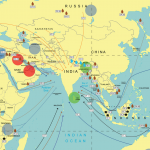Gateway House has released the India’s Global Energy Footprint map. If you are interested in securing a copy of the map, please contact membership@gatewayhouse.in
India has benefited from the last three years’ low energy prices. Our energy-dependent nation, which imports 1.3 billion barrels of oil annually, has had a windfall through the lowered price of oil, resulting in a yearly saving of almost $70 billion—a benefit shared among consumers, oil companies and the government as it rolled out its ambitious domestic development programmes.
This tailwind is now weakening. The price of the Indian crude basket averaged $62.3/barrel in December 2017 compared to $47.6/barrel during 2016-17. This means an additional annual outgo of $20 billion from the Indian economy—and less money with consumers and the government. India’s fiscal deficit from April-November has already overshot the target for the entire financial year, and high oil price will make matters worse[1].
The increase in oil price is not a one-off—there are multiple factors pushing it up.
OPEC and Russia, the world’s largest oil exporters, have successfully capped their combined oil production and have agreed to extend this cut to 2018[2]. This will help their economies because the increase in oil prices is much greater than revenue lost from lower oil production. The low price of oil of the past three years has also resulted in companies across the world cutting spending on oil exploration, resulting in declining oil discoveries. New oil discoveries crashed from 30 billion barrels in 2012 to only 7 billion barrels in 2017[3]. Fewer discoveries mean less oil in the future, so the trend in firm oil prices can be expected to continue through 2018 and beyond. Shale oil, which has been a big factor in keeping prices down in the past three years, accounts for ~5% of global oil output. If the remaining 95% of oil production is constrained, shale oil by itself cannot keep prices in check.
Because of the reduced oil supply, demand and supply are finely balanced and any negative surprises now will have a greater impact than in the past. For instance, December 2016 oil prices hit successive two-and-a-half year highs following a damaged oil pipeline in the North Sea[4], another damaged oil pipeline in Libya[5], anti-government protests in Iran[6] and inventory drawdown in the US[7]. Any serious disruption in a major oil-producing country, such as Venezuela, Iran or Saudi Arabia, can further push up prices.
So what can India do?
India has already declared the intent to shift 100% to electric cars by 2030,[8] but this is a very long-term solution and not a certainty. In the short term, over the next five years, as the economy grows, India will consume more oil than it does now. Nor are there any immediate technologically viable alternatives for heavy trucks, cooking gas and aviation fuel, the parts of oil consumption that will stay even if electric cars are widely and quickly adopted.
Two factors are still in India’s favour:
- the oil price is at a two-and-a-half year high, but currently still 40% lower than the average price from 2011-14 when it averaged over $100/barrel, the worst case scenario;
- oil prices are trending upward, but they rarely move in a smooth line. They will fluctuate, and occasionally plunge or rise.
Taking these into account, India can do the following:
- create a special arm of the finance/petroleum ministry, tasked only with hedging India’s energy exposure and a budget to achieve it. Or whenever oil prices fall, buy long-term call options to protect against high prices[9].
- public sector oil companies can be more aggressive in acquiring oil and gas fields outside India. During 2014-17, Indian companies acquired only two producing oil assets, both in Russia. They can look to the U.S. and Canada[10], which have hundreds of oil companies of all sizes and are possible targets for acquisitions. A financial investment in a U.S. or Canadian oil-producing company can serve as a proxy for buying a stake in an oil field.
The window of low oil prices has started to narrow, but it has not slammed shut yet. India can easily seize this opportunity now.
Amit Bhandari is Fellow, Energy and Environment Studies at Gateway House.
The India’s Global Energy Footprint map is available only to Gateway House members. If you are interested in becoming a member, please contact membership@gatewayhouse.in
This map was exclusively created by Gateway House: Indian Council on Global Relations. You can read more exclusive content here.
For interview requests with the author, or for permission to republish, please contact outreach@gatewayhouse.in.
© Copyright 2018 Gateway House: Indian Council on Global Relations. All rights reserved. Any unauthorized copying or reproduction is strictly prohibited.
References
[1] Raghavan, TCA Sharad, ‘Why is the fiscal deficit widening?’, The Hindu, 31 December 2017, <http://www.thehindu.com/business/Economy/why-is-the-fiscal-deficit-widening/article22339285.ece>
[2] Lawler, Alex, Rania El Gamal, & Shadia Nasralla, ‘OPEC, Russia agree oil cut extension to end of 2018′, Reuters, 30 November 2017, <https://www.reuters.com/article/us-opec-meeting/opec-russia-agree-oil-cut-extension-to-end-of-2018-idUSKBN1DU0WW>
[3] Press Release, Rystad Energy, All-Time Low For Discovered Resources In 2017: Around 7 Billion Barrels Of Oil Equivalent Was Discovered, 21 December 2017, <https://www.rystadenergy.com/NewsEvents/PressReleases/all-time-low-discovered-resources-2017>
[4] Sims, Bryan, ‘Oil settles lower after rally on pipeline outage; Brent premium narrows’, Reuters, 12 December 2017, <https://in.reuters.com/article/us-global-oil/oil-settles-lower-after-rally-on-pipeline-outage-brent-premium-narrows-idINKBN1E603J>
[5] Kumar, Devika Krishna, ‘Oil soars, U.S. crude hits $60/bbl for first time since mid-2015′, Reuters, 26 December 2017, <https://www.reuters.com/article/us-global-oil/oil-soars-u-s-crude-hits-60-bbl-for-first-time-since-mid-2015-idUSKBN1EK0DW>
[6] Zhdannikov, Dmitry & Devika Krishna Kumar, ‘Oil hits highest since mid-2015 but settles down as outages abate’, Reuters, 2 January 2018, <https://www.reuters.com/article/us-global-oil/oil-hits-highest-since-mid-2015-but-settles-down-as-outages-abate-idUSKBN1ER024>
[7] Geiger, Julianne, ‘Oil Rises As API Reports Major Draw In Crude Inventories’, Oil Price, 3 January 2018, <https://oilprice.com/Latest-Energy-News/World-News/Oil-Rises-As-API-Reports-Major-Draw-In-Crude-Inventories.html>
[8] Arora, Rajat & Vinay Pandey, ‘To go 100% electric, auto companies have to change machinery, take risk: Nitin Gadkari’, Economic Times, 5 October 2017, <https://economictimes.indiatimes.com/industry/auto/news/industry/to-go-100-electric-auto-companies-have-to-change-machinery-take-risk-nitin-gadkari/articleshow/60961602.cms>
[9] Bhandari, Amit, ‘Financial hedge for India’s oil risk’, Gateway House, 21 January 2016, <https://www.gatewayhouse.in/financial-hedge-for-indias-oil-risk/>
[10] Bhandari, Amit & Kunal Kulkarni, ‘North America: petro state’, Gateway House, 13 April 2016, <https://www.gatewayhouse.in/petro-state/>


